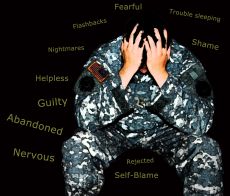Health
Lobotomy: When Treatment Helps the Doctor, Not the Patient
Sometimes attempts to alleviate suffering can go terribly wrong.
Posted February 2, 2014
By Alan Slomowitz, Ph.D.

By Alan Slomowitz, Ph.D.
Mental health professionals often feel helpless in the face of another’s extreme suffering. But we must exercise caution to ensure our interventions don’t inadvertently inflict additional pain. A chilling example of how an attempt to alleviate psychological pain can go terribly wrong was reported recently in the Wall Street Journal, The Lobotomy Files.
Traumatized young soldiers, in the prime of their lives, were forced to undergo the barbaric practice of lobotomy by ice pick. Psychiatrist Dr. William Freeman promoted this “treatment” for soldiers who had served their country in World War II. Returning from battle emotionally scarred and often violent, Freeman was convinced their mental illness was physically located in the brain. His idea was to “sever faulty neural pathways between the prefrontal area and the rest of the brain, channels believed by lobotomy practitioners to promote excessive emotions.” Today these soldiers would be diagnosed with Post Traumatic Stress Disorder (PTSD) and treated with psychotherapy and medication. But 70 years ago PTSD was poorly understood. Tragically, in an attempt to fix the brain, the doctors destroyed the men. And then the whole episode was forgotten.
The Wall Street Journal found that between April 1, 1947, and Sept. 30, 1950, VA doctors lobotomized 1,464 veterans at 50 hospitals. Overall, lobotomies were performed on almost 2,000 returning soldiers, men long neglected by the Veterans Administration. Most of the soldiers disappeared into oblivion until one day, 70 years later, this group of reporters found the archives of these soldiers and decided to tell their stories. A few of the soldiers are still alive. Some of the deceased have surviving family members who, with relief and sorrow, finally had the opportunity to speak out about the harm done to their relatives.
The stories from the Wall Street Journal can be read and heard online beginning with The Lobotomy Files: The Forgotten Soldiers. Here are just a few of the soldiers who were lobotomized:
“The forgotten lobotomy files, military records and interviews with veterans’ relatives reveal the details of lives gone terribly wrong. There was Joe Brzoza, who was lobotomized four years after surviving artillery barrages on the beaches at Anzio, Italy, and spent his remaining days chain-smoking in VA psychiatric wards.
Melbert Peters, a bomber crewman given two lobotomies—one most likely performed with a pick-like instrument inserted through his eye sockets.
And Mr. Tritz, the son of a Wisconsin dairy farmer who flew a B-17 Flying Fortress on 34 combat missions over Germany and Nazi-occupied Europe.
“They just wanted to ruin my head, it seemed to me,” says Mr. Tritz. “Somebody wanted to.” Mr. Tritz was a man who went to war apparently healthy and returned home to the “unrelenting din of imaginary voices in his head.” He was treated with 28 rounds of electroshock therapy as well as insulin induced coma therapy before his lobotomy. Today he describes himself as “mentally injured not mentally ill.”
In July 1943 a memo landed on the desk of Frank Hines, Administrator of the Veterans Administration (VA), who was not an MD. The memo stated lobotomies had a mortality rate of “only” (quotes added) 2%-4%, did not require surgical skill, could be performed under local anesthesia, and psychiatrists could be trained easily. Dr. Freeman recommended psychiatrists do this and not surgeons! Mr. Hines approved the procedure. No reviews, no studies, just go ahead and do it.
Horrifying, but keep context in mind. The first Lobotomy was performed in 1935 by Dr. Egas Moniz, a Portuguese physician. The idea was to cure mental illness by cutting out the diseased part of the brain. He won a Nobel Prize in Medicine for his work. Dr. Freeman performed his first lobotomy in 1936. Over the course of his career, he is reported to have performed over 3500 lobotomies, some on children as young as 4 years old.
Then this ugly episode was erased from cultural memory, not unlike the doctors’ attempt to erase the soldiers’ traumatic memories. When humans are overwhelmed by anxiety and uncertainty they have an amazing capacity to not know what they already know—in this case, that while the treatment relieved the doctors’ feeling of helplessness, it unintentionally damaged soldiers.
Dr. Elliot Valenstein, a psychologist who worked at the Topeka VA makes a critical point: “You couldn’t help but have the feeling that the medical community was impotent at that point.” They were certain mental illness must be located in the brain and Dr. Freeman’s conviction reassured doctors they were healing suffering veterans, that they were able to be helpful and effective.
When patients evoke feelings of helplessness in us it can be difficult to distinguish between our own anxiety and the patient’s. Discomfort with someone’s suffering can be a powerful force prompting extreme measures, and we sometimes make questionable choices.
The Lobotomy Files is a tragic cautionary tale for us all as we walk a fine line between treatment and destruction. Anxiety has the power to seriously disrupt our judgment. At these moments, it is imperative to remember the words of Hippocrates: First, do no harm.
Alan Slomowitz, Ph.D., is a psychoanalyst and clinical psychologist. He is a graduate the William Alanson White Institute. Dr. Slomowitz is the Internet Editor of the Contemporary Psychoanalysis in Action blog, He is a supervisor of psychotherapy at the Beth Israel Medical Center Dept. of Psychiatry and at the Ferkauf Clinical Psychology Health Emphasis Ph.D. Program. Dr. Slomowitz is in private practice and his office is at Columbus Circle on the Upper West Side.




